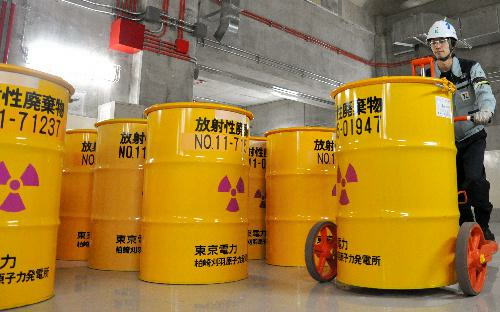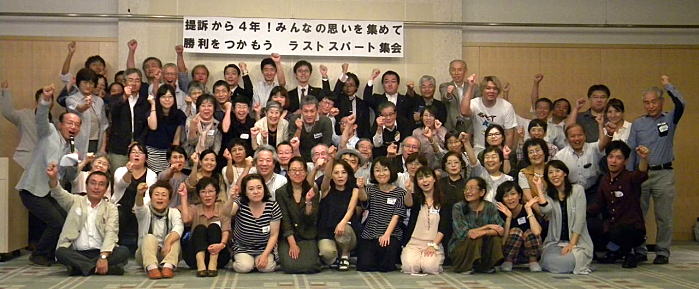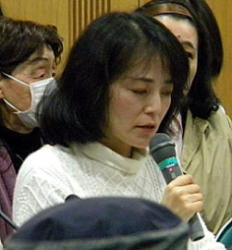|
|||||||||
Statements for the conclusion of the Kyoto Judgement on 29th September 2017:(Read in pdf) Japanese
1. From Atsuko Fukushima, one of the joint representatives of the plaintiffs in The Damages Suit, Kyoto: Radiation is invisible and odourless. We are terrified of the radioactive pollution which was spread by the nuclear disaster. Moreover we have health damage, anxiety and actual harm. I am sure that we made this damage visible to the judges through our lawyers' pleading, testimonies from experts with an international level of knowledge and plaintiffs from the 57 households who courageously stood up in the courtroom. The reactors at the Fukushima Daiichi nuclear power station descended into an uncontrollable state shortly after the mega earthquake on the 11th March 2011. Huge amounts of radioactive substances were released by the explosion and vented from the reactors. And the radiation has spread beyond the nuclear site to where people were living and worldwide. The Declaration of a Nuclear Emergency Situation by the Government still continues even though six years have passed since the disaster. It means the disaster hasn't finished yet. The Government has raised the public safety limit for radioactive exposure dose after the nuclear disaster. The citizens of Fukushima have been forced to live in this situation. Furthermore the Government left a policy vacuum and stopped housing support for evacuees as they said that reconstruction was essential. The up to 50mS/year evacuation zone was lifted by 2011, thereby exposing citizens unnecessarily to radiation. I went to Minamisoma city in Fukushima this summer. I used to see piles of black container bags on the way to Minamisoma city from Fukushima city. But this time I didn't see the tons of bags which contained highly contaminated soils except in Iitate village. I borrowed my dad's car and went to Namie town. The decontamination work has been carried out for scattered houses to prepare for lifting the evacuation zone. Heavy trucks loaded with tons of the black bags were passing non-stop by the seashore. When I got out of dad's car and looked at the Ukedo river where salmon used to swim, I was stunned by the piles of black bags by the riverside. Many bags were broken and weeds were growing from them.  Ms Atsuko Fukushima at the Fukushima demo How can the Government say to us to stop our evacuation and return to the contaminated areas in order to help with their reconstruction? I know an evacuee who was abused by a member of an assembly, who said 'You are only a few percent of the Fukushima population. You are an obstacle to reconstruction by the government.' I was also told this and was told 'Come back to Fukushima and let's do our best.' The Fukushima citizens are told 'do the best' again and again and again, and it made it difficult for us to mention the nuclear disaster and radiation. Even the evacuees' existence has nearly been deleted. It is easy to imagine that residents who live around Fukushima could be treated even worse than Fukushima citizens if they talk about the problem. When we were cross-examined in the courtroom, we were repeatedly asked same question: 'Don't you want to go back to Fukushima with the present radioactive dose level?' I felt the absurdity of people asking this question. After all they themselves are living with a much lower radioactive dose than Fukushima's. We just want to escape from areas with over 1mSv/ year radioactive exposure which is the legal radioactive dose limit for the public. That's why try very hard to we keep evacuating. As most plaintiffs have described, the nuclear disaster hasn't ended. We continue to evacuate, because we can't sweep away our anxieties until the dose level returns to how it was before the disaster. My big concern is not just this point. Even if the contamination of radioactive materials has decreased after millions of years have passed, the severe heavy metal pollution from the broken reactors of the Fukushima Daiichi Nuclear Plants will remain and threaten the world. This issue must be tackled immediately and countermeasures around Fukushima must be worked out. These problems are too numerous. The right of the public to information is controlled, a visible thing is led towards invisibility and an invisible thing is led towards looking it never existed in the first place. I urge that the Government and TEPCO need stop this vicious circle, accept their responsibility, investigate the causes of the accident, compensate for our damage and change towards taking positive measures. Every individual defendant and their families have the right not to be exposed to radiation. We kept appealing for our human rights domestically and overseas. One of our plaintiffs will appeal to many countries about our treatment by the Japanese government at the United Nations. I hope that the judge will be courageous and make a judgement that will shine brightly in posterity.
Page top 2. Yukimi Hagiwara, one of joint representatives of the plaintiffs in The Damages Suit, Kyoto This is my statement of opinion. I might be asked why I didn't go to see a doctor? I felt our health condition might not be an emergency. Also I didn't want to be pessimistic about my children's future and for them to be labelled with the diagnosis of some disease. We had enough physically and mental hurt already. If I thought about the situation, I would be unnerved. I had to pretend like nothing happened in daily life, otherwise I would lose the strength to live. I didn't have enough time, energy and strength to go for regular health checks. I hope our hard-pressed situation will be understood. This didn't happen just to my family. Most plaintiffs can talk about this issue, but hesitate to write a statement. I have talked with our plaintiffs regularly as a group representative. We couldn't tell all our stories in statements and individual examinations as we wanted. Some plaintiffs became nervous or found it hard to concentrated because of bad health or being too busy. The damage we had suffered was too wide to explain. I feel misery, and I am sure that many of us have the same feelings which express our hurt. Please accept our right to evacuation. Even if some plaintiffs evacuated from one of the areas with a lower level of contamination, these places have radiation levels higher than the level of low-level radioactive waste (over100Bq/kg) which must be stored and controlled in yellow drums for ten times it's radioactive half-life. Children shouldn't live and grow in these places. Nuclear waste is actually strictly controlled in the yellow drums at the Kashiwazaki Kariwa nuclear power plant, even though it is at lower levels of radioactivity than our home town. Why are our children allowed to play on soil with much more contamination? This is too unfair!  Drums of radioactive waste at the Kashiwazaki Kariwa nuclear power plant I shed tears when I see my children play on sports days where is no contaminated soil. My mixed feelings mean I can't stop crying when I think of my father, brother, sister, relatives and friends. And I feel safe and appreciate that I could leave the disaster affected-areas. We become emotional when we listen to music which is connected to our home town. It shows how deep our psychological trauma is. Although the level of food contamination has decreased, I don't want to add to my internal exposure by eating even a few Becquerel from the disaster areas. Some local people including my father eat wild vegetables or produce from a kitchen garden which are not tested radiation. It is not possible to avoid internal and external exposure completely through air dose, the selling of illegally contaminated food, the deceptive labelling of the origin of food, and the contaminated of soil that the Government doesn't mention. Finally, I appreciate all the people who are involved in this court case. Because of the acceptance of lawyers of both sides, the plaintiffs and defendants, we could file a suit. Thankfully this means the actual circumstances can become known by the public. I think the defendant's sincere attitude will save the world from the nuclear threat. They can say 'Regarding compensation, I will do that which I can do, but I won't do that which I can't do. But I apologise and admit that the facts are as the plaintiffs say.' I hope that the facts of the damage from the Fukushima Daiichi nuclear disaster will be known openly, and that all living things will be respected.
Page top |
|||||||||
| Copyright (C) 2017 Support group for plaintiffs and the Nuclear Power Plant Lawsuit for Compensation in Kyoto All Rights Reserved. |



